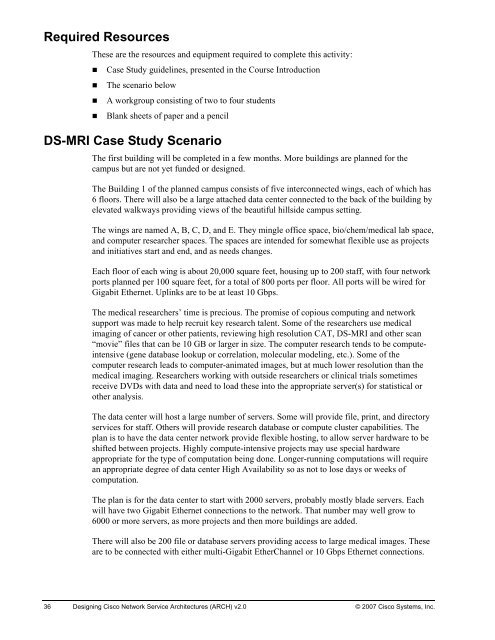Designing Cisco Network Service Architectures - Free Books
Designing Cisco Network Service Architectures - Free Books
Designing Cisco Network Service Architectures - Free Books
You also want an ePaper? Increase the reach of your titles
YUMPU automatically turns print PDFs into web optimized ePapers that Google loves.
Required ResourcesThese are the resources and equipment required to complete this activity:• Case Study guidelines, presented in the Course Introduction• The scenario below• A workgroup consisting of two to four students• Blank sheets of paper and a pencilDS-MRI Case Study ScenarioThe first building will be completed in a few months. More buildings are planned for thecampus but are not yet funded or designed.The Building 1 of the planned campus consists of five interconnected wings, each of which has6 floors. There will also be a large attached data center connected to the back of the building byelevated walkways providing views of the beautiful hillside campus setting.The wings are named A, B, C, D, and E. They mingle office space, bio/chem/medical lab space,and computer researcher spaces. The spaces are intended for somewhat flexible use as projectsand initiatives start and end, and as needs changes.Each floor of each wing is about 20,000 square feet, housing up to 200 staff, with four networkports planned per 100 square feet, for a total of 800 ports per floor. All ports will be wired forGigabit Ethernet. Uplinks are to be at least 10 Gbps.The medical researchers’ time is precious. The promise of copious computing and networksupport was made to help recruit key research talent. Some of the researchers use medicalimaging of cancer or other patients, reviewing high resolution CAT, DS-MRI and other scan“movie” files that can be 10 GB or larger in size. The computer research tends to be computeintensive(gene database lookup or correlation, molecular modeling, etc.). Some of thecomputer research leads to computer-animated images, but at much lower resolution than themedical imaging. Researchers working with outside researchers or clinical trials sometimesreceive DVDs with data and need to load these into the appropriate server(s) for statistical orother analysis.The data center will host a large number of servers. Some will provide file, print, and directoryservices for staff. Others will provide research database or compute cluster capabilities. Theplan is to have the data center network provide flexible hosting, to allow server hardware to beshifted between projects. Highly compute-intensive projects may use special hardwareappropriate for the type of computation being done. Longer-running computations will requirean appropriate degree of data center High Availability so as not to lose days or weeks ofcomputation.The plan is for the data center to start with 2000 servers, probably mostly blade servers. Eachwill have two Gigabit Ethernet connections to the network. That number may well grow to6000 or more servers, as more projects and then more buildings are added.There will also be 200 file or database servers providing access to large medical images. Theseare to be connected with either multi-Gigabit EtherChannel or 10 Gbps Ethernet connections.36 <strong>Designing</strong> <strong>Cisco</strong> <strong>Network</strong> <strong>Service</strong> <strong>Architectures</strong> (ARCH) v2.0 © 2007 <strong>Cisco</strong> Systems, Inc.
















